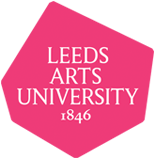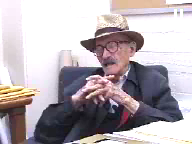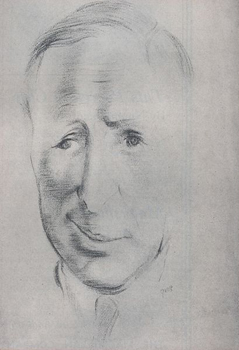
Thomas Hart Benton was an American painter, muralist, and printmaker. Along with Grant Wood and John Steuart Curry, he was at the forefront of the Regionalist art movement. The fluid, sculpted figures in his paintings showed everyday people in scenes of life in the United States.

Leeds Arts University is a specialist arts further and higher education institution, based in the city of Leeds, West Yorkshire, England, with a main campus opposite the University of Leeds.

The Corcoran School of the Arts and Design is the professional art school of the George Washington University, in Washington, D.C. Founded in 1878, the school is housed in the Corcoran Gallery of Art, the oldest private cultural institution in Washington, located on The Ellipse, facing the White House. The Corcoran School is part of GW's Columbian College of Arts and Sciences and was formerly an independent college, until 2014.
Events from the year 1901 in art.

American Regionalism is an American realist modern art movement that included paintings, murals, lithographs, and illustrations depicting realistic scenes of rural and small-town America primarily in the Midwest. It arose in the 1930s as a response to the Great Depression, and ended in the 1940s due to the end of World War II and a lack of development within the movement. It reached its height of popularity from 1930 to 1935, as it was widely appreciated for its reassuring images of the American heartland during the Great Depression. Despite major stylistic differences between specific artists, Regionalist art in general was in a relatively conservative and traditionalist style that appealed to popular American sensibilities, while strictly opposing the perceived domination of French art.

Jules Engel was an American filmmaker, painter, sculptor, graphic artist, set designer, animator, film director, and teacher of Hungarian origin. He was the founding director of the experimental animation program at the California Institute of the Arts, where he taught until his death, serving as mentor to several generations of animators.
Roger Medearis was an American Regionalist painter.
Associated American Artists (AAA) was an art gallery in New York City that was established in 1934 and ceased operation in 2000. The gallery marketed art to the middle and upper-middle classes, first in the form of affordable prints and later in home furnishings and accessories, and played a significant role in the growth of art as an industry.
Jackson Lee Nesbitt was an American printmaker, teacher, painter, and ad executive. He took pride in calling Thomas Hart Benton a teacher, a mentor and his friend. Jack stayed true to his regionalist roots despite the dominance of Abstract Expressionism and he enjoyed the resurrection of his career at age 75.

Marguerite Munger Peet (1903–1995) was an American painter. She did not have a far-reaching artistic reputation during her lifetime as she did not often exhibit her work in public. Her family found over 430 of her paintings after her death, and she has been the subject of three major retrospectives in the last 15 years. Her most significant work was created under the tutelage of famed American Regionalist painter Thomas Hart Benton.
Frederic James (1915–1985) was an American painter who specialized in watercolors. He was associated with the Regionalist art movement.
John Stockton de Martelly (1903–1979) was a lithographer, etcher, painter, illustrator, teacher and writer.

Thomas Craven was an American author, critic and lecturer, who promoted the work of American Regionalist painters, Thomas Hart Benton, John Steuart Curry and Grant Wood, among others. He was known for his caustic comments and being the "leading decrier of the School of Paris."
Joan Elizabeth Woollard, PPRBSA was a Birmingham, England born artist, mainly specialising in sculpture. She was a member of the Royal Society of British Sculptors and a member of the Royal Birmingham Society of Artists (RBSA) as well as being its first female President between 1978 and 1980.
Richard Shaw is an American ceramicist and professor known for his trompe-l'œil style. A term often associated with paintings, referring to the illusion that a two-dimensional surface is three-dimensional. In Shaw's work, it refers to his replication of everyday objects in porcelain. He then glazes these components and groups them in unexpected and even jarring combinations. Interested in how objects can reflect a person or identity, Shaw poses questions regarding the relationship between appearances and reality.

Tornado over Kansas, or simply The Tornado, is a 1929 oil-on-canvas painting by the American Regionalist painter John Steuart Curry. It depicts a dramatic scene in which a family races for shelter as a tornado approaches their farm, and has compositional connections to Curry's earlier 1928 painting Baptism in Kansas. The artist is believed to have been influenced by Baroque art and photographs of tornadoes. He developed a fear of natural disasters and a reverence towards God during his childhood, both of which are apparent in the painting.

James Duard Marshall was a painter, lithographer, museum director, and art conservator who lived most of his life in Kansas City. Duard [pronounced "doo-erd"] was a student of Thomas Hart Benton and is best known for his 30-foot mural created for the centennial of Neosho, Missouri in 1939. The civic leaders of Neosho had approached Benton to produce the mural, as Benton had been born in Neosho, but he suggested that his student Marshall do the job. That mural hangs in the Neosho Newton County Library.

Jack Edward Barber was an American artist working in oil, egg tempera, acrylics, watercolor, lithography, and sculpture.










